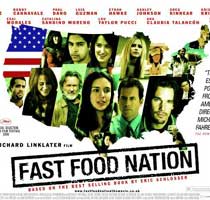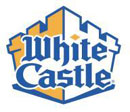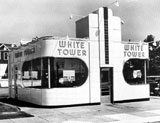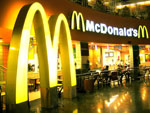Fast food nation《快餐帝国》(精讲之二)
影片对白

Don: Thanks, Louise.
Jack: Donny boy. Have a seat. Thanks for stopping by. So, what do you think of everything?
Don: It's good, good. I'm glad to see the Big One doin' so well.
Jack: Hmm. Listen, you ever run into a guy named Harry Rydell, executive V.P. Out of the Chicago office?
Don: I don't think so.
Jack: He works closely with our suppliers. A little too closely, if you ask me.
Don: What do you mean?
Jack: I have a friend that teaches food science over at A&M- microbiology. And this semester, a couple of his grad students decided to culture some patties from a bunch of fast-food chains.
Don: Mm-hmm.
Jack: Well- They got a hold of a couple of Big Ones- frozen patties. Don't ask me how. And the fecal coliform counts were just off the charts. I'm concerned that this could be a problem for us. Do you understand what I'm saying?
Don: Uh- Not exactly.
Jack: I'm saying there's shit in the meat.
妙语佳句,活学活用
1. I don't think so.
“我想没有吧”。当你不确定什么事,或是要对某事表示否认的时候,就可以用到这句话。
2. Get a hold of
Hold 作名词时有“抓住,握住,控制”的意思,在这里get a hold of 的意思是“取得,拿到”。
3. off the charts
Off the charts 的意思是“Extrodinarily out of the norm; beyond expectation; top of the line超出标准,超出期望,一组中最高的”,本身是没有褒贬的。例如:His new car was off the charts!
4. Concern
Concern 在这里的意思是“担心,担忧;关心,关照”,常与with, about, in连用,例如:
We're rather concerned about father's health.
5. Not exactly
“不是很(清楚/明白)”,当你要表示对别人所说的事情不怎么了解的时候,就可以用到这句话。其实生活和工作中用到的场合有很多。尤其是你在和领导沟通的时候,如果你直接说“我不明白”是不是显得你很不开窍?用 not exactly 就会好很多。
文化面面观
快餐工业的历史
What is termed "fast food" in the United States today most commonly consists of hot, freshly prepared, and wrapped food items, served to customers across a counter or through a drive-up window. Known as both "fast food" and "quick-service food" in the restaurant industry, these items are routinely sold and delivered in an amount of time ranging from a few seconds to several minutes; they now vary widely in food type, encompassing virtually all kinds of meats, preparation methods, and ethnic cuisines. Inexpensive hamburgers and french fried potatoes are still the products most readily identified as fast food, but the list of items sold in the format continually increases. Fried fish and shellfish, hot dogs, chicken, pizza, roast beef, and pasta are commonly sold at quick-service outlets. In addition to these staples, many quick-service restaurants sell a broad menu of Americanized Mexican, Greek, and Chinese foods.
The precise origins of fast food are vague, probably predating written history. Hungry people are as old as civilization itself, as are entrepreneurs eager to satisfy their hunger. Food vendors in ancient cities sold prepared items to passersby on the street.

Our modern image of the fast-food restaurant dates back to 1916, when Walt Anderson began selling "hamburger sandwiches" from an outdoor stand on a Wichita street corner. Anderson simply flattened a meatball and placed it between two halves of a bun. His sandwich quickly became popular, attracting long lines of hungry buyers. By 1921, Anderson had joined local insurance broker Edgar "Billy" Ingram to form the White Castle System. After opening several identical restaurants in Wichita during their first year, the partners quickly spread their business to neighboring cities, then to nine major urban areas throughout the Midwest and on the East Coast. What separated the White Castle System from earlier short-order restaurants was its very streamlined menu, comprising only hamburgers, coffee, Coca-Cola, and pie; a uniform architectural style; and strict standardization of food quality, preparation methods, and employee performance. By the close of the 1920s, White Castle's aggressive marketing and rapid spread had made the hamburger one of the most popular foods in America.

Other entrepreneurs soon noticed White Castle's success in the hamburger business. Very closely copying White Castle's products, architecture, and company name, competing new chains also thrived, carrying the hamburger craze across the nation to smaller cities and towns. The White Tower chain appeared in 1925, eventually challenging White Castle's dominance in several northern cities. Krystal's, opened in 1929 in Chattanooga, soon became the hamburger powerhouse of the southeastern states. White Castle's hamburger sandwich, along with its many imitators, became a daily staple for many working-class Americans. It proved so successful, in fact, that by 1930 the president of the American Restaurant Association identified the fast-food hamburger as the most important food item in the nation.

Hamburgers became even more a mainstream food during the 1930s. The larger restaurant chains began marketing their products to middle-class buyers, and even more Americans became burger lovers. Despite the harsh economy of the Great Depression, most fast-food chains continued to thrive, and in many cases grew considerably. Most continued selling the White Castle–style hamburger, but late in the decade the Big Boy chain spread east from California, introducing its new double-decker hamburger sandwich along the way. By the end of the Depression, America was a solidly hamburger-eating culture.
After prospering in the Depression, however, the fast-food industry suffered a serious setback during World War II. Shortages of necessary foodstuffs, such as meat, sugar, tomatoes, and coffee, meant limited menu offerings and often a significant loss of business. Attempting to continue providing meals to their customers, fast-food restaurants experimented with different items that were still in abundance, including soy patties, chili, and French fried potatoes. Even more damaging than commodity shortages was the very low unemployment rate, which meant that most workers bypassed the restaurant industry in favor of higher-paying work. Adjusting to this labor shortage, chains soon replaced their all-male workforce with women and teenagers, two groups who would become their most common employees. Despite attempts to find palatable alternative foods, and despite the shifts in workforce, much of the fast-food industry was a casualty of the war; by 1945, more than half of America's restaurants had closed down, including several of the major fast-food chains.

As population shifted from America's cities to suburbia during the 1950s, the fast-food industry quickly followed. Early chains such as White Castle and White Tower, resisting moving to the suburbs, were quickly eclipsed by upstart franchised chains. Burger King and McDonald's outlets became common fixtures at suburban crossroads, selling burgers, fries, and shakes to hungry families. Burger King's Jim McLamore and McDonald's Ray Kroc each sought to build one of his restaurants in every American town, and they opened hundreds of new Burger Kings and McDonald's each year in the 1960s. To accomplish this rapid expansion, they relied heavily on franchise investors, enforced strict product uniformity throughout their chains, and aggressively

advertised in every newly opened territory. With McDonald's and Burger King's success, Burger Chef outlets soon appeared nearby. Arby's, Kentucky Fried Chicken, and Taco Bell were not far behind. By the late 1960s, fast food no longer meant just hamburger restaurants, but had diversified to include quick-service pizza, roast beef, chicken, and tacos. To give an idea of the dimensions to which the fast-food industry has grown, in 1999 Americans consumed over 26 billion pounds of beef, much of it as hamburgers. In that year McDonald's alone had more than ten thousand restaurants in the United States, from which it grossed in excess of $13 billion in revenue.
考考你
用今日所学将下面的句子译成英语。
1. 研究人员说,结果“远远超出标准”。
2. 我担心你的话会损害我们团队的形象。
Fast food nation《快餐帝国》(精讲之一)考考你 参考答案
1. S.H.E. have been a big hit over the last three years.
过去三年S.H.E.歌唱组合非常受欢迎。
2. What's this new evidence built on?
新证据建立在什么之上?
3. I am building on the relationship with my father.
我正在改善和父亲的关系。
相关文章
- Million dollar baby《百万美元宝贝》精讲之三
- Million dollar baby《百万美元宝贝》精讲之二
- Million dollar baby《百万美元宝贝》精讲之一
- The princess diaries《公主日记》1 精讲之六
- The princess diaries《公主日记》1 精讲之五
- The princess diaries《公主日记》1 精讲之四
- The princess diaries《公主日记》1 精讲之三
- The princess diaries《公主日记》1 精讲之二
- The princess diaries《公主日记》1 精讲之一
- From the earth to the moon《从地球到月球》精讲之五




 手机网站
手机网站